
Women in leadership: From under-representation to the sentiment gap
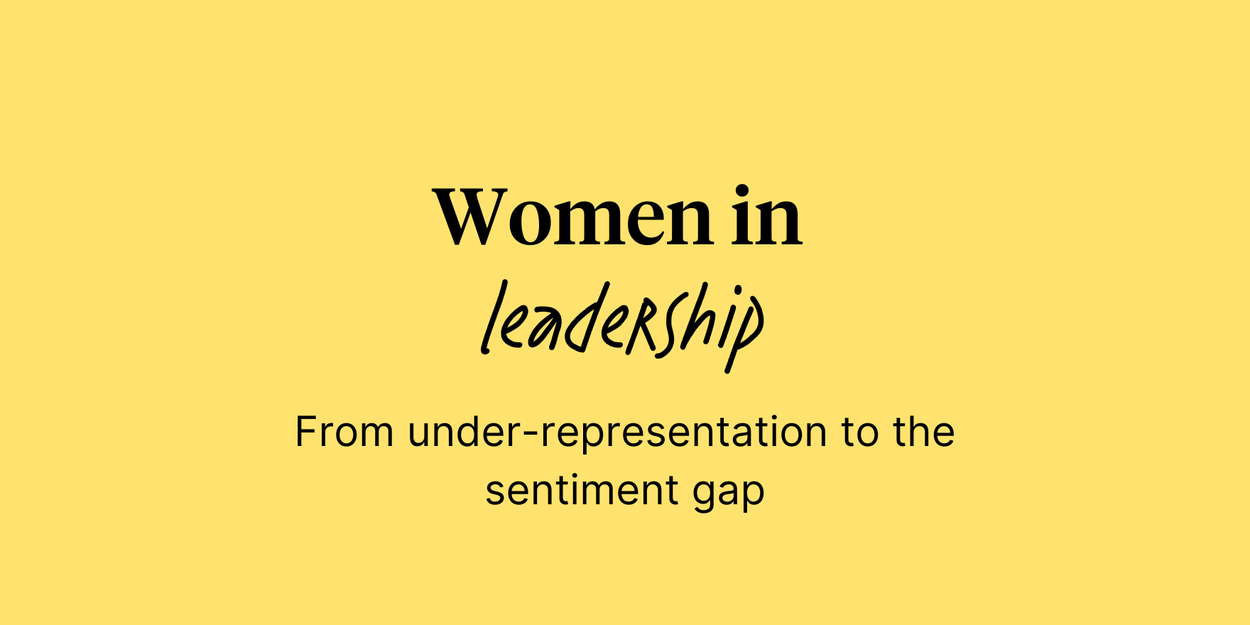
Written by

Senior Data Journalist, Culture Amp

Director of People Science Research, Culture Amp
We all know about the gender pay gap – it’s pesky, persistent, and despite years of efforts, it remains a stubborn reality. A similar gap persists in leadership. Getting a seat at the table isn’t enough. That speaks only of presence, not of treatment and working conditions. For women who break through the proverbial glass ceiling, what is the experience actually like? It turns out, not so great. We hope that exposing this gap in how women and men leaders experience their roles will catalyze change.
The harsh truth of gender representation in leadership
The higher up you look in an organization, the fewer women you’ll find. To understand the experience of women in leadership, we analyzed enterprise-level company data accounting for over 1.3 million employees. For this study, we compared companies that have at least three women leaders to a broader set of companies with fewer women. We did this to avoid bias in smaller group sizes. We found that even in companies with three or more women, there is a gap between how men and women leaders experience their positions of leadership.
We found that while 51% of individual contributors are women, this drops to 39% at the VP level and only 30% at the C-suite level. The World Economic Forum shows a similar statistic – women account for 25% of the C-Suite. It could be that companies who use Culture Amp are ahead of the trends (accounting for the extra 5% above what the WEF reports), and that we will start to see gender representation increase moving forward, or something else may be at play. Where all datasets align is that as you move up the organizational hierarchy, there are fewer and fewer women.
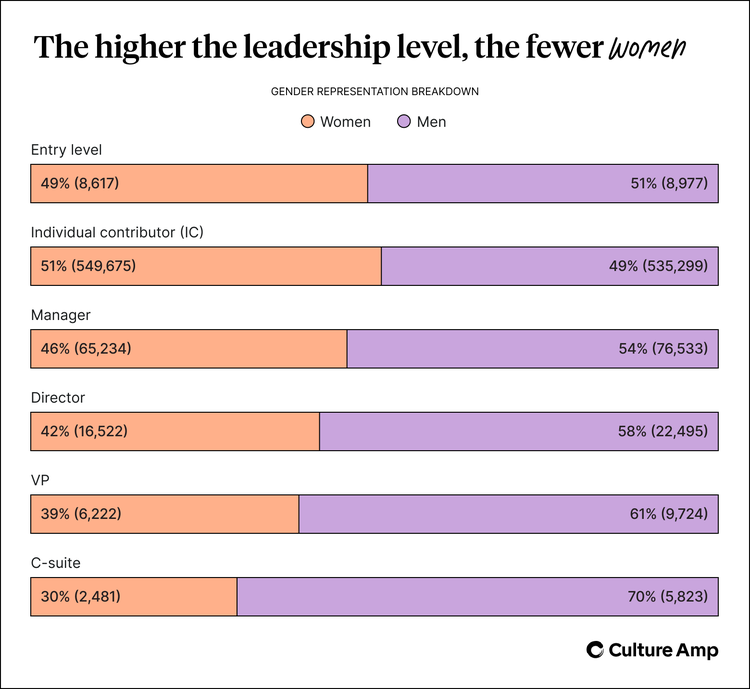
What is getting in the way of women reaching the C-suite?
An article from MIT Sloan points out that female employees are 14% less likely to get promoted than their male peers. Why? Because not all performance management processes have equity built in. Many companies still rely on metrics that value and rate employees on their potential, which often unfairly disadvantages women. While ratings on potential likely contribute to this disparity, our data suggests a more complex picture.
Our recent DEI report found that women were less likely to agree that people from all backgrounds had an equal opportunity to succeed at their respective workplaces. When we ran the same analysis on our larger dataset and spliced by leadership level, we found that by and large, the higher the leadership level, the less likely a woman is to perceive opportunities as equitable. The only level where women agree to a higher extent than men is entry level. We’ll chalk that one up to inexperience.
The same pattern emerges when employees are asked if the right people are being rewarded and recognized. The higher up the leadership ladder you go, the bigger the sentiment gap between men and women.
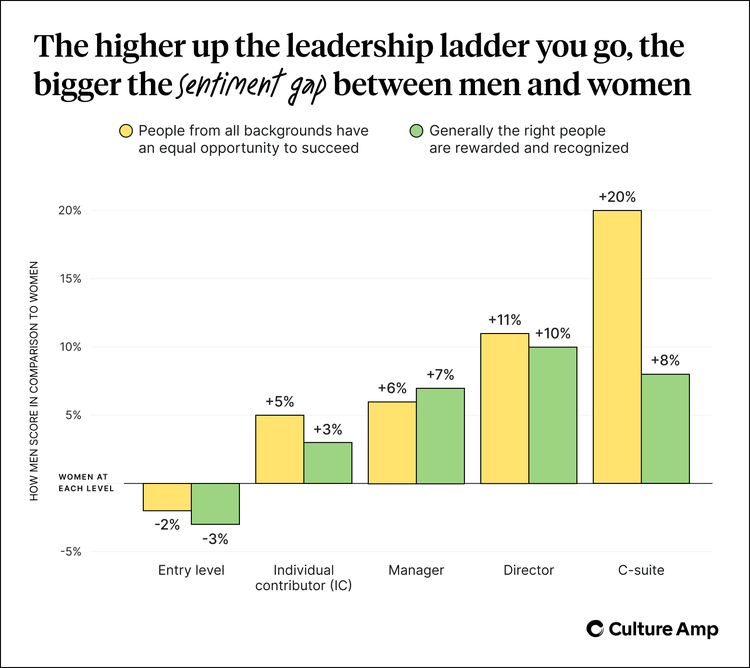
And when it comes to performance management processes, we see a meaningful difference between men and women only in the highest levels of the organization: at the VP and C-suite levels. As men ascend the organizational structure, their perception of fairness in the performance management process improves (with the caveat of entry-level employees who are often in the honeymoon phase) – a phenomenon to which women appear immune.
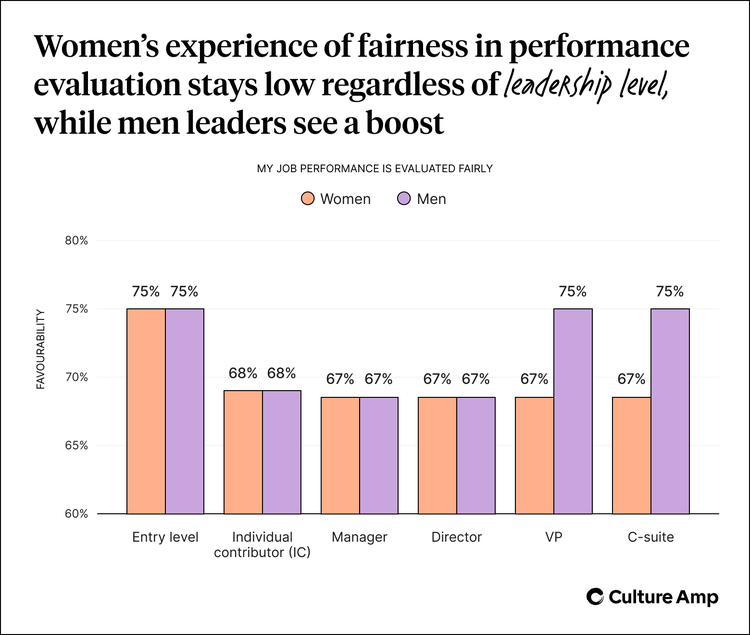
Our data shows women, particularly women in leadership roles, experience performance management, career progression, and recognition differently than men. Since these are the main inputs for promotion and compensation decisions, it's unsurprising that fewer women are ascending the ladder. But for those who are able to ascend, what is the experience like?
If we look at all leaders, we find they are having a much more favorable experience
According to our data, leaders are having a markedly different experience to employees. They are scoring meaningfully higher than employees across the board, but particularly across the items that indicate leaders are hearing employees’ needs, wants, and efforts. Survey items like those rating leaders themselves, action taken based on recent survey results, and recognition serve as examples.

It may be the case that leaders are closer to where action is being planned, closer to fellow leaders to witness their impact, and so on. Or, it could be that leaders are disconnected from the experience of their employees. These findings complement a recent study by Deloitte, which found that though employees reported their health as either dropping or staying the same, over 75% of leaders believed their workforce’s mental health had improved.
The disconnect between leaders and employees is especially pronounced at the C-suite level, where we see up to a 20% difference between executive leaders and individual contributors. And yet, not all in the C-suite are having such an elevated experience..
When we compare women and men executives, women leaders appear to be experiencing the workplace more akin to employees at lower levels than fellow men leaders.
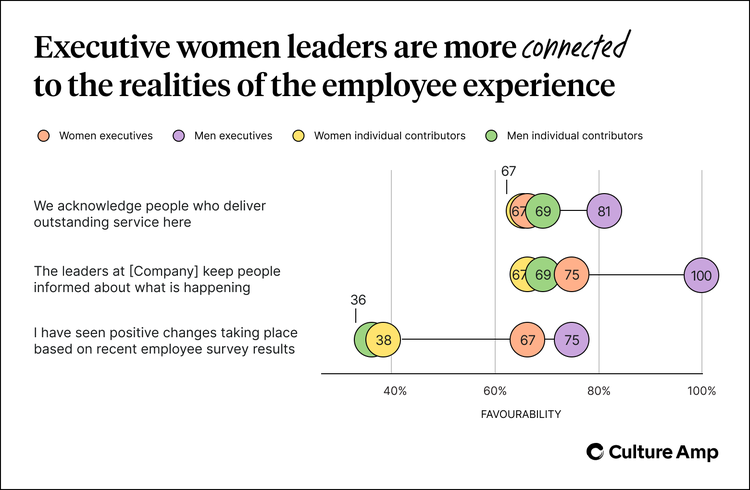
When we look at the psychological state of inclusion, we spot a potential explanation as to why C-suite women may be more connected to lower-level employees.
Of 5,800 men in the C-suite who rated the statement “When I share my opinion, it is valued,” all of them agreed. Of women in the C-suite, less than 90% agreed. The same pattern exists for feelings of belonging and respect, though the differences between men and women grow even larger – up to 25% for respect.
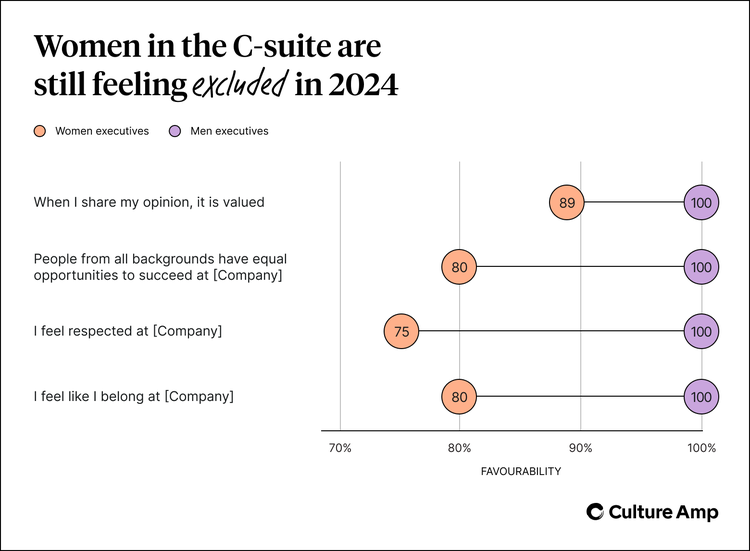
At best, these disparities could motivate women to serve as vital connectors between the C-suite and the rest of the organization, grounding the elevated perspectives of their male peers. At worst, the gaps suggest a “no girls allowed” sign on the closed door of the “boys’ club.”
If this exclusion of women leaders makes them more attuned to the areas of the business that need improvement, it stands to reason that organizations with women leaders are better positioned for success. This would be consistent with findings elsewhere. If the business, employees, and male C-suite peers all benefit from the feelings of exclusion women leaders experience, the ultimate cost is paid by women in leadership.
Women leaders are left out of what, for men, is a heightened experience at the top
Businesses gain from the unique perspectives women leaders bring, so understanding what drives their experience is crucial for retention.
For women in the C-suite, the strongest driver of commitment to stay at a company is the company’s commitment to diversity. This is unique to women at only the highest leadership level. In contrast, commitment to diversity is a weak driver of commitment to stay for men in the C-suite, ranking at 63rd out of 69 potential drivers.
Women at the table bring a keen eye for improvement, a byproduct of often being overlooked. But progress comes at a personal cost. Equality isn’t just about having a seat, it’s about having a voice that’s truly valued. Companies that champion inclusion unlock the full potential of their leaders, and themselves.
Julie Knight
Chief Marketing Officer, Culture Amp
The impact of sentiment gaps
The sentiment gap for women in the C-suite is particularly concerning. Women leaders at this level report a worse-than-average experience, especially in areas that influence their commitment to stay. This suggests that women might leave the C-suite early due to systemic roadblocks, opting to find opportunities elsewhere rather than continually battling obstacles their male peers do not face.
Actionable steps for creating a more equitable experience
So, what can organizations do today to create more equity for women in leadership positions? Here are three actionable steps:
1. Foster inclusion and DEI across all levels:
- Implement structured sponsorship programs that pair director and VP-level female leaders with senior executives who can offer broader recognition across the organization.
- Measure your company’s DEI progress against global benchmarks laid out in our 2024 DEI report, and take action to improve critical areas.
2. Improve systems and processes:
- Develop transparent criteria for promotions, and ensure all employees are aware of these standards.
- Regularly review and audit your performance management process to remove biases.
- Audit your tech stack, selecting tech that is accessible and user-friendly.
3. Make decision-making more equitable:
- Utilize decision-making frameworks (e.g., DACI) to ensure multiple perspectives are considered in critical business decisions.
- Standardize a decision-making process that raises critical questions about power dynamics, psychological safety, and voice.
The state of women in leadership is complex and multifaceted. While there are bright spots – such as women leaders having a better pulse on the employee experience – significant challenges remain, especially around inclusion and systemic barriers. Organizations that address these issues head-on to ensure women leaders can thrive and make meaningful contributions at the highest levels are likely to outperform those that do not.

Build a more diverse & equitable workplace
Understand the current state of DEI at your organization, pinpoint focus areas, and run intersectional analyses to guide meaningful action.



